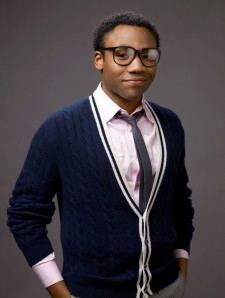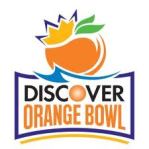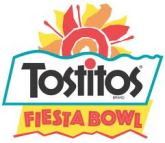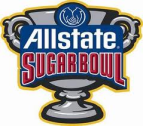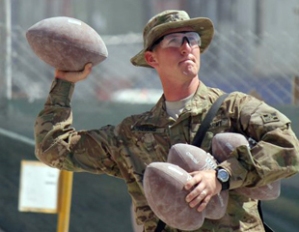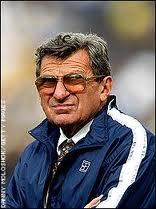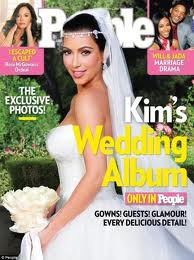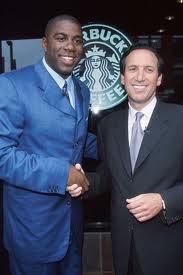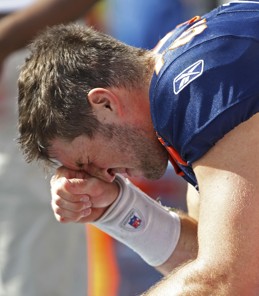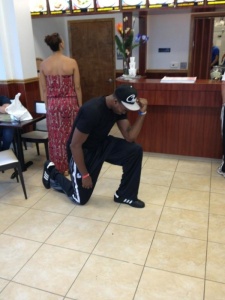Pop Culture: Donald Glover (“Childish Gambino”) Has Been Far From Childish About Taking Over The Hip Hop Game
Tuesday evening, June 26, 2012, was the first night in which New York City was granted a reprieve from a four-day heat wave that had crushed the eastern seaboard. I jumped on the F Train after work in business attire with one thing in mind: get to Prospect Park, Brooklyn as soon as possible to snag a good spot for the hottest concert of the summer. Unlike any other concert I’ve been to, I was totally overdressed in a suit (primarily as a result of my lack of preparation), but the funny thing is that I knew I wouldn’t stick out like a sore thumb amongst the crowd. I was off to see 28-year-old, preppy actor and comedian, hipster, Atlanta native, and now hip hop superstar Childish Gambino, a name Donald Glover adopted from a Wu-Tang Clan online name generator.
The doors opened at 6 pm, I arrived around 7:15 pm to meet up with a law school buddy, and I immediately felt at home and welcome. Surrounding me were guys and gals in ripped up jean shorts and wife beaters; business casual attire; preppy polo shirts, jeans and driving loafers; and oversized white tees, baggy jeans and Air Jordans. The age demographic ranged from early teens to late thirties. Moreover, I’m quite sure the audience consisted of every race, religion and socio-economic class. By around 7:45 pm, two great opening acts—Danny Brown and SchoolboyQ—reverberated the evening air. I grabbed a frosty beer, loosened up the dress shirt, caught up with a couple of old friends who I randomly bumped into, and prepared myself for the best act I’ve seen on stage since The Roots/Outkast concert in Los Angeles back in the early 2000’s in college.
Around 8 pm, the crowd immediately converged towards the stage as the choir intro to “Outside”—the first song on Glover’s most recent album CAMP—began to blare through the amphitheatre speakers. Childish entered from stage left, pierced a thick cloud of blue smoke, and completely KILLLED the stage until 10:30 pm, at which point he was forced to call it a night due to neighborhood noise ordinances. He and his live band followed “Outside” with popular hits “Fire Fly” and “Bonfire”. At this point, the audience assumed Glover would perform all of his songs from the album CAMP in their normal order. Indeed, CAMP recently sat at the #11 spot on the Billboard Top 200 Chart and the #2 spot on the Billboard Hip-Hop charts. Then, he surprised us with some of his early underground hits such as “Hero”, “Freaks and Geeks”, “Lights Turned On” and “My Shine” from his July 2010 album Culdesac and March 2011 untitled EP. The audience, apparently consisting of individuals who had been fans of Childish since the release of his first album Sick Boi in 2008, went absolutely nuts. Of course, Glover didn’t exit the stage before performing his 2011 remix of Adele’s “Rolling in the Deep”. Indeed, during this song, all of Brooklyn attempted to touch the sky.
Overall, actor and comedian Donald Glover—aka Hip Hop star Childish Gamibino—is an extremely talented individual. We knew this fact! However, I realized on the evening of Tuesday, June 26th that he is taking over the Hip Hop game. He has singlehandedly branded himself in a strategic manner, compelling one of the most diverse demographics of all time to adore and crave his music and energetic stage presence. Hip Hop enthusiasts could attempt to compare him to the extremely talented Mos Def or an artist such as Lupe Fiasco, but he has transcended Hip Hop and captured the Millennial Generation like no other artist I can recall. The New Yorker Magazine expounds, “with a vocal attack reminiscent of Pharcyde’s Bootie Brown, Glover delivers rapid-fire stream-of-consciousness one-liners, along with in-depth and intelligent assessments of the recording industry, fame, and fortune.” But don’t take my or any other source’s word for it. Snag his recently released July 4, 2012 album ROYALTY and/or catch him during his upcoming “CAMP” Tour that will grace the stages of 20 cities (thus far) across the globe.
“CAMP” Tour Dates:
June 25—Central Park Summerstage—New York, New York
June 26—Prospect Park Bandshell—Brooklyn, New York
July 1—Couleur Café Festival—Brussels, Belgium
July 3—Melkweg—Amsterdam, Netherlands
July 4—Xoyo—London, England
July 6—Wireless Festival in Hyde Park—London, England
July 7—T In The Park—Balado, Scotland
July 25—Beaumont Club—Kansas City, Missouri
July 27—Time Warner Cable Uptown Amphitheatre—Charlotte, North Carolina
July 28—The Orange Peel—Asheville, North Carolina
July 29—The National—Richmond, Virginia
July 31—Echo Beach—Toronto, Ontario
Aug. 1—Metropolis—Montreal, Quebec
Aug. 3—The Fillmore—Detroit, Michigan
Aug. 4—The Vic—Chicago, Illinois
Aug. 5—Lollapalooza—Chicago, Illinois
Aug. 10—Hollywood Palladium—Los Angeles, California
Aug. 17—The Academy—Dublin, Ireland
Aug. 18—V Festival—Chelmsford, England
Aug. 19—V Festival—Stafford, England
Aug. 20—King Tut’s—Glasgow, Scotland
Aug. 25—Rock En Seine—Paris, France
Oct. 14—Austin City Limits—Austin, Texas
Fansagainstviolence.org enlightens us regarding new California Legislation
Thanks to our friends at FAV (www.fansagainstviolence.org), we received an update today concerning the proposed California legislation “Improving Personal Safety at Stadiums Act.” The organization notes that “[i]t is FAV’s mission to encourage fan safety at professional sporting events through education, discussion and partnerships with like-minded organizations. We believe that attending sporting events is an act of fellowship and community between fans, and that each person who attends a professional sporting event should feel safe and be protected by the hosting facility and franchise.” Kathy Samoun, a devoted Oakland Raiders fan, founded the organization and authored today’s enlightening article. Among other things, she explained that the California Assembly Committee on Arts, Entertainment, Sports, Tourism and Internet Media unanimously adopted the legislation today following several critical amendments to the proposed bill. Certainly, this new California legislation could be the catalyst to compel other states to create necessary change. Please click on the link above to enjoy Kathy’s article and further support a great organization!
Where the Regulation of Violence in Sports Will Inevitably Extend: The Stands & Outside the Stadium/Arena
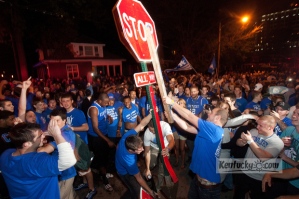
The University of Kentucky fans "celebrate" the Wildcats' Final Four win over Louisville to gain a spot in the National Title game.
The professional and college sports industries have without question reached milestones with respect to revenue generation over the past decade. Both the National Football League and the National Basketball Association experienced pre-season lockouts and subsequent consuming negotiation sessions with their respective players’ unions concerning profit sharing. In 2010, the NCAA signed a monumental $10.8 billion contract with CBS Corporation and Time Warner Inc.’s Turner Broadcasting for the media rights to its beloved Men’s Division I College Basketball Tournament, known by most as March Madness.
It goes without saying that fans are the impetus behind such revenue growth. Whether a country and its citizens are facing a recession—even bankruptcy—or marvelous economic times, avid followers and fans of professional and college sports teams will pay hard-earned money for the pleasure drawn from watching talented athletes perform for up to three hours on the field, court or ice. Fans will do so by attending such events, watching them at bars/restaurants, or through the purchase of oversized, flat-screen televisions for home. David Levy, the President of Turner Sports, acknowledged in signing the March Madness media contract with the NCAA that “the tournament’s popularity and success [had outgrown] the ability for one network to provide all the coverage fans are looking for.” Similarly, CBS News and Sports President Sean McManus recognized, “the opportunity for viewers to watch whatever game they want to on up to four different networks has to result in more eyeballs, more gross rating points and more exposure for the tournament, thereby creating much more value for the advertisers.”
I think it’s awesome that fans of professional and college sports teams continue to use this source of entertainment as an escape from the struggles facing the lives of individuals on a daily basis in many countries around the globe, including financial turmoil, disease, death and general unhappiness. However, over the same decade that the sports industry has experienced rapid revenue growth and increased popularity, the fan experience at and following sporting events has become more violent, tragic and unpleasant. A problem clearly exists that neither the professional leagues, the NCAA Directors nor the athletes have sufficiently addressed, or are even equipped to address.
Indeed, the European professional soccer leagues have essentially condoned fan violence since their creation. The Philadelphia Eagles’ late Veterans Stadium maintained holding cells to accommodate unruly fans. These facts represent proof that the sports industry has accepted violence as part of the overall fan experience for quite some time. For instance, in 2004, Lakers forward Ron Artest—or as legal documents now refer to him, Metta World Peace—climbed into the stands as an Indiana Pacer at The Palace of Auburn hills to exchange punches with a few rambunctious fans. In 2010, I attended a New York Jets game in New York as an Atlanta Falcons fan and was threatened by four Jets fans following the Falcons’ last minute defeat of the Jets. Fortunately, violence never ensued, though not as a result of action taken by stadium security. In 2011, a San Francisco Giants fan experienced the wrath of Dodger Stadium when several Dodger fans beat him almost to the point of death. And just a few weeks ago, University of Kentucky basketball fans nearly burned down and destroyed Lexington, KY, following the Wildcats’ Final Four win over state rival Louisville to gain a spot in the National Title game.
However, what has either been condoned or overlooked by these leagues and the NCAA will inevitably draw a divide between fans, compelling those who are visiting the home stadium or establishment (e.g., sports bar) of an opposing team to discontinue their participation. This decreased fan participation and interest will inevitably compel revenue to decline for the professional sports leagues, the NCAA, media outlets and corporate partners and sponsors. Should violence and unpleasant behavior by fans persist at or following sporting events, how could it not have a domino impact on the sports industry?
So, where should we as fans and professionals in the industry place blame and seek assistance in preventing this evolving problem? First and foremost, responsibility should be placed on the individuals who are involved in such inappropriate behavior. Fans have progressively turned their allegiance to sports teams into something personal. However, sustaining a loss through a favorite team is not analogous to losing a love one. Fans must realize that their personal lives will continue unscathed, so long as they categorize sporting events as entertainment and nothing more. This point allows me to transition to my second and final position. The professional sports leagues, the NCAA, the athletes, the media outlets and the corporate partners and sponsors must take on the responsibility of reminding fans of this fact. Indeed, most professional sporting venues stop serving alcohol at a certain point during team play. College venues refuse to serve alcohol altogether. Great, by taking alcohol out of the picture, these entities and individuals have indirectly implied to the fans that they should behave responsibly. However, I’m asking—maybe even pleading to—these same entities and individuals to make a direct and blatant statement to the fans: “Stop the violence and inappropriate behavior!” The NFL has already done so much to prevent violence on the field in an effort to protect its brand and revenue stream. Take the next step and prevent it from occurring in the stands and outside the stadium.
Hey guys, it’s your money, not mine, that’s being placed on the line.
A Belated Defense of Kendrick Perkins
This piece was written by guest author Jack Rollo, a lawyer and sports & entertainment enthusiast. Please welcome him to the THIRDandFOUR family.
I would like to thank Chris Ryan for being unable to let something go. A few months ago, LA Clippers star Blake Griffin threw down a rather impressive dunk on Oklahoma City’s defensive-minded center, Kendrick Perkins. At the time, many commentators felt that it was necessary to not only praise Griffin’s athleticism, but to mock Perkins — who was simply trying to do his job — as well. This was disgraceful, and, sadly, representative of the sports media (and media in general) as a whole. I wanted to write something about it, but I was too busy and time passed. Now, two months later, Chris Ryan has decided to refer back to Griffin’s “postering” of and “mid-air obituary” for Perkins. In doing so, he perpetuates the most negative aspects of the media, but has reopened the door for me to say my peace. So thanks again, Chris Ryan.
Kendrick Perkins plays defense. And he plays it hard. Because of this, it is widely known that Perk is a Beast. Now, it shouldn’t be noteworthy that a man who gets paid millions of dollars to play a game actually works hard on the defensive end of the floor, but it is. Perkins is limited in his offensive abilities, but he is unquestionably a valuable NBA player because he is a large man (even by NBA standards) who plays defense and grabs rebounds with a fury that far exceeds most others in the league. This fury led to Perkins trying to defend Griffin on a play where, in reality, Perkins had little chance of defensive success. Griffin is too big, too athletic, had too much momentum, and was too close to the rim for Perkins to stop him. Of course, in real time, it’s hard to make that kind of judgment, so Perkins tried and failed. Griffin threw down an incredible dunk. Perkins was posterized.
This same fate has fallen upon other NBA players, which makes sense. If you work on the defensive end, it almost certainly will happen to you. Some of your opponents will have extraordinary physical gifts, and your attempts to stop them will be in vain. Of course, other NBA players are never posterized. They avoid doing so in a rather simple manner: they don’t attempt to play defense. When an opposing player elevates to dunk, they simply let him do so. Nobody ever writes their “mid-air obituaries.” They never look foolish on SportsCenter’s Top 10 Plays of the Night.
In fact, SportsCenter’s Top 10 probably perhaps best captures the problem I am addressing. How often on the Top 10 do you see some version of the following: “A monster dunk by Player X. His team lost by 20 points” or “A monster dunk from Player X, but he had a rough night overall. He shot 2-847 from the floor and had eleventy billion turnovers”? If his team got crushed or he had a terrible game, why should we celebrate Player X’s monster dunk? He had a bad night. He did not help his team win. He did not perform his job. We are celebrating the momentary individual achievement over the team. We are celebrating the meaningless over the valuable.
And in team sports, one of the most valuable attributes a player can have is defensive intensity. It is no coincidence that NBA champions frequently have a player on their roster who is there for his defense. Defense is fundamental to winning, and it’s fundamentals that should be celebrated. Kobe Bryant best illustrates this point. Bryant is a star because he is a prodigious scorer, but he is one of the greatest players of all time because of his fundamentals. He is widely known as one of the league’s elite defenders. Even his scoring is predicated largely on fundamentals, as he has one of the greatest mid-range games of all time. This gets ignored. Watch the Top 10 and tell me how many mid-range jump shots you see.
What I want is for us to celebrate consistent hard work and effort over a single flashy play; celebrate substance over style. Bryant has his fundamentals because he is a notoriously obsessive worker. Likewise, defensive success is predicated mostly on tenacity. Perkins, on that famous play, put forth effort and came up short. There are countless plays, however, where Perkins’s effort will lead to success. The Oklahoma City Thunder are one of the best teams in the league, one of the most complete teams in the league, and one of the favorites to at least reach, if not win, the 2012 NBA title. Kendrick Perkins is a major reason why.
We should all approach work and life the way Perkins plays defense. Work hard. Be tenacious. Make the most of the talents we have. And when we see our personal Blake Griffin charging toward the hoop, have the courage to step in and try to stop him, even if we probably can’t. Griffin’s dunk on Perkins should not be referred to as “postering” or a “mid-air obituary” or any other crime against the English language. It should be referred to as a man, Perkins, working hard to do his job and, in one moment, failing to succeed. Perkins should be praised, not mocked. Regardless, I would imagine that, because Perkins is a professional, he has shaken off that night and that moment. I would imagine he still plays defense with heart and without fear. I hope so. It’s a lesson that all of us can and should import into our own lives. Here’s hoping the sports media find some cute terminology to promote that story, too.
– Jack Rollo
Fixing the Bowl System
As I sit here in the midst of yet another over-hyped, under delivering college bowl season, I’d like to focus on a postseason issue that often takes a backseat to the “playoff vs BCS” debate – how do we make the entire college bowl system more enjoyable?
Not to sound like an old fuddy duddy – but when I was growing up, the college bowl system was a glorious week and a half of football that culminated with what used to be the best day of the year, New Year’s Day. Of course, that was back when it was permissible to play more than one bowl game at a time, and different networks even competed for the rights. There were also built in rivalries that made the games exciting, the games were based on when fans could travel instead of when it was good for television ratings, and most importantly, you played for a final ranking or pride – which meant that games outside national championship game actually mattered.
Now, the bowl system is a mess. Nobody really cares about any games outside of the BCS Title Game and going to a bowl game is no longer a special occurence, since 50% of all teams in college football are “rewarded” with a bowl game. So how do we fix it? Here are a few suggestions.
1. Condense the Bowl Season
I know that the popular argument is to just restrict the number of bowl games. But given how much money is at stake for the bowl committee, the host city, and the conferences playing in them, that’s just not going to happen. Maybe there will be some natural contraction of bowls that don’t make money, but we’re not going back to an 18 bowl system like we had in 1991. Instead, let’s shorten the bowl season. Right now, the bowl season basically starts 2 weeks after the regular season final games have been played and extends until a week after New Year’s. That’s almost 3 1/2 weeks of bowl season. That’s too long for any fan to pay attention. The minor bowls are barely a blip on anyone’s radar as it is, playing them on December 19th means even less people are watching. The same goes for any bowl game after New Year’s Day – unless its the BCS Title game, nobody cares, or has time to watch. The bowl season should start on December 23rd and other than the BCS Title Game go until January 2nd. Sure it’s a short span of time to cram in a bunch of games, but college football fans are notorious for spending hours in front of the TV watching, why wouldn’t they do that for bowl games too?
2. Create Continuity in the System
One of the reasons nobody pays attention to the bowls any more is because the names keep changing. Or more accurately, the sponsors keep changing. If you want to sponsor a bowl, make a 5 year commitment. That way I won’t be confused when the Big Ten plays in the Dallas Football Classic Bowl in one year and then the TicketCity Bowl next year. Name changes are inevitable, but let’s at least try and create some long term brand value. Along those same lines, let’s keep conferences tied to the same games for extended periods of time – and do our best to keep those tie-ins alive every year. That used to be the norm, but it seems like every year there is a fill-in for a BCS game, or a new conference tie in for the Gator Bowl. If you want to build excitement for bowls, you have to create year to year rivalries that allow teams and conferences to build up animosity. The Big Ten and SEC have some of that with their tie-ins for the Capitol One Bowl, Outback Bowl and Gator Bowl, but there needs to be more of this. Fans should know that just like the Rose Bowl is the Big Ten vs the Pac 12, the Holiday Bowl is the Big 12 vs. the Pac 12 and the Cotton Bowl is the Big 12 vs the SEC. These rivalries used to be played up, now they are just an afterthought.
3. Flashback to New Year’s Day 1991 Part 1
In 1991 there were 18 bowl games – 8 of which were played on New Year’s Day. That meant for college football fanatics like myself, you could kickoff your day with the Hall of Fame Bowl 11 AM, and have back to back games going until 11 PM at night, when the Orange and Sugar Bowls were ending. 12 hours of football, 8 great matchups, and plenty of channel flipping. It made for an incredible day, with multiple television setups and competing games adding to the fun. On New Year’s Day 2010, of the 34(!) bowls, a whopping 5 were played on New Year’s Day. Last year, the addition of another bowl game gave us 6 bowl matchups on New Year’s Day, a step in the right direction in terms of quantity, but not quality. Several of the bowls were sub-par matchups that included a 7-5 Michigan vs 8-4 Mississippi State and a 7-5 Northwestern vs a 7-5 Texas Tech in the TicketCity Bowl. Compare that to 1991, where the only games slotted on New Year’s Day were marquee matchups. New Year’s Day should be reserved for the best games between the best teams. If your bowl puts the #6 Big Ten Team vs. the #7 SEC team, please enjoy December 30th.
4. Flashback to New Year’s Day 1991 Part II
The other reason the bowls were more fun to watch in 1991 is that not only were the marquee games reserved for January 1, but they were actually played on January 1! Ever since ESPN has taken over the bowl system (33 of 35 bowls will be broadcast by ESPN this year), they’ve taken all of the competition out of things by spreading out the games over several days. Instead of a 4 PM kickoff on New Year’s Day of both the Rose Bowl and Fiesta Bowl, followed immediately by the Sugar and Orange Bowls, each game has its own timeslot. Each of the 4 marquee bowls is the only bowl being played at that time. While that’s great for attracting more viewers, it also means that if the game isn’t that competitive, I’m switching to something totally different. The NHL has wisely seized upon this with the NHL Winter Classic – now fans have an option if the Rose Bowl is a blowout. Part of the fun of New Year’s Day is that it was like the Super Bowl of college football – an all day party of games that kept you watching even if you didn’t have a dog in the fight. The 1991 Sugar Bowl matchup between Tennessee and Virginia probably wasn’t must-see TV for me, but since it was on New Year’s Day, I tuned in. I happen to be a Michigan fan, so I’ll absolutely tune in for the Sugar Bowl on January 3rd this year, but the Orange Bowl battle between Clemson and West Virginia will probably only garner as much interest from me as your standard Saturday night ESPN SEC game. I may watch, but I’m not planning my night around it. And I think most fans feel the same way. Instead of spreading the bowls out, why not build excitement for the one day of the year where everybody can watch? You may lose some “viewers” due to channel flipping, but you won’t lose excitement or interest over the bowl games. Plus, now that we live in a Twitter world, if something exciting is happening in your game, fans will know to tune in.
5. Flashback to 1991 Part III
One of the original reasons behind the entire bowl system was to create tourism for certain places around holiday time. Fans could pick their Christmas and New Year’s destinations based on where their favorite team was playing, and in most cases, enjoy a vacation somewhere warm like California or Florida – a great perk for the northern schools. Unfortunately, with the modification of the bowl schedule has scrapped all of that for many fans. With 5 bowl games being played on January 3rd, 4th, 6th, 7th and 8th, you have several games that are very difficult for fans to travel to because of work/school scheduling. Parents just can’t pull their kids out of school these days just because the college team is playing on the Wednesday after New Year’s. Likewise, most people don’t have that flexibility of work to miss an extra couple of days to start the New Year. And the same goes for six games played before December 24th – nobody can travel the week before Christmas or after New Year’s because they have other responsibilities. Yet bowl officials and schools can’t understand why they have trouble selling out their allotment of tickets. The solution is simple – get back to the basics. Plan your bowls around when it is convenient for fans to travel and make the experience user friendly. I guarantee the host cities would benefit from more fans who stick around for a longer period of time, instead of those who fly in the day before (or morning of the game) and fly out the next day. Let the game be a holiday destination, like it was meant to be.
6. Traditional Bowl Matchups
I know I started this post saying that I wasn’t interested in addressing the BCS/Playoff argument. I lied. Sort of. I’m not going to advocate for a playoff system to choose a champion, or even a +1 BCS scenario. Instead, let’s take a step backward, and revert back to the way we used to choose a National Champion – with voting. In truth, its not that different than what we have now. The BCS just gives a game between #1 and #2 that is decided by the voters, and it guarantees that teams that don’t finish the regular season #1 or #2 have no shot at the title. Therefore, we’re told that the only bowl game that matters is the BCS Title Game. That’s unfair to the other bowls, and is frankly, shortsighted.
Let’s say that we reverted to the modified old bowl tie-ins, with the SEC Champ in the Sugar Bowl, the ACC and Big East Champs in the Orange Bowl, the Big 12 Champ in the Fiesta Bowl, and the Big 10 and Pac 12 Champs in the Rose Bowl. Both the Fiesta and Sugar Bowls would have an at-large selection too. The major conferences in the major bowls, with no BCS BS to decide who gets to play where. The 2011 version would look something like this (notice its not that different).
Rose Bowl – #8 Wisconsin vs. #5 Oregon
Orange Bowl – #15 Clemson vs #22 West Virginia
Fiesta Bowl – #3 Oklahoma State vs at-large
Sugar Bowl – #1 LSU vs at-large
The at-larges would clearly be #4 Stanford and #2 Alabama – so you might get the same matchups in the Sugar Bowl (Alabama vs LSU) and the Fiesta Bowl (Stanford vs Oklahoma State) anyways. Or, you could end up with LSU playing Stanford and Oklahoma State vs Alabama. In either instance, if LSU wins, they are the clear #1 team and would win the National Championship. But let’s say we take Scenario B and LSU loses to Stanford and Oklahoma State trounces Alabama. Suddenly Oklahoma State has a strong claim to the title and we’ve made the Fiesta Bowl a lot more compelling.
Sure, the Orange Bowl is still a mediocre matchup, but the other offshoot of this is that since we’re not so focused on just #1 vs. #2, the Rose Bowl regains some of its luster. And in years where there are unbeatens or one loss teams from more than 2 conferences, every major bowl game might be a showcase for a team trying to lay its claim to the national championship. And without so much focus on #1 vs. #2, teams will again take pride in trying to finish as a high as they can. As it stands now, there’s no difference between finishing #3 or #14 in the minds of most fans/teams. That didn’t used to be the case.
The trade off is that we won’t guarantee that #1 will play #2, but its not like the BCS is the perfect system it supposedly is. I’d be happy with scrapping the BCS if it meant that the other bowls actually mattered again. Wouldn’t it be great to spend New Year’s Day monitoring all of the major bowls and wondering whose style points would sway the voters?
I’m not naive enough to think that all of this, or frankly any of this, will happen. But there was a time when college bowl games were exciting, and in some cases were must see TV. There was a time when bowl games were profitable and teams played in full stadiums with thousands of fans making the trip to see the game. And there was a time where I could spend my New Year’s Day with 3 TV’s lined up next to each other, enjoying 8 or 9 games from 11 AM to 11 PM. I’ll still enjoy the 6 games I get to watch today, but I’ll be disappointed knowing how great this day used to be and with a few tweaks, still could be.
Thanksgiving
As I woke up this morning and scheduled my Thanksgiving day, which included determining whether to eat breakfast or maintain an empty stomach for dinner, whether I, at age 30, could muster up enough confidence to ask my mother if I could eat dinner while watching football, and whether I could feasibly touch base with all of my friends and family on this holiday, it hit me! In the illustrious words of John F. Kennedy, on Thanksgiving, “as we express our gratitude, we must never forget that the highest appreciation is not to utter words, but to live by them.”
Now, as I sit before my Parents’ “only in America must I purchase this size” television and watch the first of three NFL games scheduled for today, I observe individuals who truly live by their words on this Thanksgiving day. First and foremost, I see American soldiers stationed at army bases in Iraq, Afghanistan and a number of other regions who are football fans and watching the same game as me. The NFL has provided a live broadcast of these troops rooting for their respective teams to display its and America’s appreciation for these soldiers and their role in risking their lives while keeping our country safe. While these soldiers put on a happy face via the FOX broadcast, you can’t help but realize that they must maintain at all times in the back of their minds the thought that potential violence is just around the corner, or maybe even just over their shoulder. They are all stationed in violent war zones, yet they live by their promise to this country on Thanksgiving day to protect us so that we can–among other things–enjoy our family and friends, stuff our faces, and overindulge in football, carbohydrates, and discounts on items at stores around the country.
Secondly, I observe well-paid individuals strap on pads and a helmet and spend either their Thanksgiving afternoon or evening entertaining America…and even other parts of the world. Though these football players on average make more money annually than 99.99999% of Americans, they step onto football fields within stadiums and domes around this country and work on Thanksgiving day. They work hard. They are passionate about what they do. As a direct result, football entertains Americans and, in certain instances, permits these individuals to either forget about the fact that they got laid off, lost a family member or friend, or learned that they are ill. Football is a blessing for many on Thanksgiving day, even for our soldiers. As a direct result, NFL players live by their promise to the League and, to a certain extent, this country on Thanksgiving day to entertain us Americans and provide us a sense of joy for at least one day out of the year.
Accordingly, thank you to our soldiers and others who work so hard on Thanksgiving day to permit Americans to be so thankful for everything and everyone around them.
NBA Athletes and Their Hip-Hop Counterparts
Written by Guest Author Marcus Banks
Executive Editors: Nicholas R. Hector & Andrew Fine
About the Author: Marcus Banks graduated from Franklin Pierce University in 2010. He has previously worked for the National Basketball Association, THG Sports and Entertainment, Turner Sports, and Turner Broadcasting and Entertainment. He is now attending New York Law School and hopes to pursue a career in entertainment/talent and sports management.
I would like to first give a shout-out to Nick and Andrew for allowing me to share my thoughts. Second, what follows consists solely of my thoughts and nothing more. If anyone disagrees with me, please don’t take offense and feel free to provide me feedback through comments. Now without further ado, I present to you my first article for THIRDandFOUR, “NBA Athletes and Their Hip-Hop Counterparts.”
Over the past couple decades, The NBA has been infused by hip-hop culture, notwithstanding Commissioner David Stern’s disdain towards a comparison of his “white-collar” league to a group of talented yet sometimes rebellious individuals. Nonetheless, many of the league’s players have embraced the analogy. As a result, I shall attempt to write about something that, based on my knowledge, has never been previously addressed; I will draw strict comparisons of influential NBA Athletes to their hip-hop counterparts.
I’ll start with my God-father Jay-Z and his counterpart Kobe Bryant. I recognize that this comparison is not obvious, but hear me out. In my opinion, Kobe is arguably the best individual to ever play the game and Jay-Z is the best individual to ever pick up the microphone. For those asking, what about Jordan or Magic, don’t worry, we’ll get there. People have argued that Kobe is good, but the reason that those same people will never consider him the singular greatest basketball player of all time is because he never played against Jordan—the greatest NBA player in most people’s eyes during his prime. During Jordan’s prime, Kobe represented the kid with the afro who ran around the court and shot air balls, all the while veterans like Nick Van Exel gave him dirty looks. In contrast, Jordan was a star on the court. When Kobe eventually hit his prime, or at least commenced his ascension towards it, Jordan’s career was essentially done and he had commenced his ebb towards retirement.
Likewise, Jay-Z spent most of his career battling “ghosts.” I consistently hear he will never be better than Biggie and/or Tupac, but truth be told, you can never make a legitimate argument regarding that comparison because he never had an opportunity to battle either one of them. Just like Kobe and Jordan, when Biggie held the throne, Jay-Z was running around in Hawaiian shirts attempting to make a name for himself.
truth be told, you can never make a legitimate argument regarding that comparison because he never had an opportunity to battle either one of them. Just like Kobe and Jordan, when Biggie held the throne, Jay-Z was running around in Hawaiian shirts attempting to make a name for himself.
When he hit his prime (aka “took over the rap game”), Biggie and Tupac were gone. R.I.P.
Additionally, for the lack of better words, Kobe Bryant is starting to appear worn-out. His performance in the 2010-11 playoffs was not too impressive; though, he got very little help from Pau Gasol. However, the Kobe we all know and love and/or hate, would’ve put the Lakers on his back and pulled them through the challenge to complete the three-peat. The same performance withdrawal has plagued Jay-Z. Every Jay-Z album has been a great compilation of music. But his last performance on the album “Watch the Throne” was far from his best work. As a whole, the album was a masterpiece, but it often sounded like a Kanye West album featuring Jay-Z, rather than a compilation. Now, don’t get me wrong, I still regard Jay-Z as the best lyricist, but he seems either a little disinterested or repetitive in his flow. Maybe that’s just what happens when you’re worth half of a billion dollars. Whatever the reason, he no longer provides the same level of aggression and rawness that we have grown accustom to experiencing and appreciating. And when I say, “we,” I mean the real Jay-Z fans and not the ones who just started listening to him upon his release of The Blueprint album. You can possibly make the argument that Jay-Z is more like a Bill Russell, primarily because of Russell’s eleven rings and Jay-Z’s eleven number one albums. You can also make the argument that Jay-Z is more like Jordan because he’s the greatest NBA player of all time. Whatever your argument might be, more power to it. I would love to hear it. But, as I previously mentioned, my argument is based primarily upon the fact that Jay-Z will never have an opportunity to go up against Biggie or Tupac, particularly when all three artists were in their prime; nor will Kobe ever have an opportunity to go up against Jordan or Magic when all three athletes were in their prime.
Next on my list is J. Cole and his counterpart Derrick Rose. There are many reasons why these two individuals mirror each other, so let’s start at the beginning: Derrick Rose is slowly taking over the game of basketball. But what I love most about him is the way he is doing it. He has attacked the sport like a snake lying in wait for his prey. He has not made a big spectacle out of it nor has he been abrasive. Moreover, he’s quietly becoming an on-the-court assassin. When Derrick Rose steps on the floor, you know he’s bringing 100% effort and heart, much like a modern day version of Allen Iverson who can also pass the ball exceptionally well. D-Rose may not have the best jump shot, but it’s improving.
To further touch upon D-Rose’ assassin mentality, in the 2008-09 Bulls vs. Celtics playoff series, many of you probably recall that Ben Gordon was clutch and that John Salmons had his coming out party. What many people fail to notice is that Derrick Rose—as a rookie—had a solid 16 points and 6 assists per game. Derrick Rose is considered the future of the NBA, particularly for those fans who like gritty and aggressive basketball players, rather than a bunch of “pretty boy” jump shooters. Derrick Rose serves as a reminder of when some of us adults were kids playing basketball in the park: when you got the ball and if you were man enough, you drove to the basket, took the hit, probably switched hands and maybe even impressed yourself with a lay-up that miraculously went into the basket. Finally, Derrick Rose is very reserved and smart, doing his best to protect his brand and professional image. You won’t find him living too lavishly or beyond his means or in the streets with an entourage.
The same sentiments translate to J. Cole. I remember the first time that I heard J. Cole rap. I experienced the same feeling that I received when I first saw Derrick Rose play basketball at Memphis as a freshman. I just knew that if he fell into the right environment and remained focused, he would take over the industry as a hip-hop artist one day. J. Cole is slowly becoming the most relevant rapper in the industry. He paid his dues, took his time and is progressively getting better. Just like Derrick Rose, J. Cole is taking over his profession quietly and strategically. His growth is most evident if you listen to his first mix-tape through his current album. He is not the best lyricist, but he’s certainly getting there. He has become more versatile, developed a better flow, displayed more charisma, expounded on genuine issues, and become a better performer. If you enjoy real hip-hop music—not the nonsense that we’ve dealt with for a while now—J. Cole is your guy.
Moreover, J. Cole, similar to D-Rose, is also very reserved and smart and is doing a good job thus far of preserving a solid image. For instance, J. Cole has both turned down a limo ride from P. Diddy and a diamond chain from a jeweler. Why? Well, because at the time, he had just signed his record deal with Roc Nation and didn’t want to promenade around New York City as if he was “the man.” Most importantly, he knew that he had not reached that level yet. J. Cole is a breath of fresh air, a sign that good music is still possible, a sign of better days to come. Last but certainly not least, J. Cole’s debut album hit number one on the billboard charts, which was much deserved. When J. Cole creates lines like, “I promise baby you can bet the bank on me,” you can’t help but notice his humble confidence. These two words wouldn’t normally find themselves aligned, but when you consider Derrick Rose and J. Cole, the description fits them perfectly. They are both so talented, they know it, yet they don’t boast about it. In fact, they are both extremely underrated. When Derrick Rose won the NBA MVP award this past season, the“naysayers” criticized the League’s choice, saying he was good but not good enough, or that he was not better than Chris Paul or Deron Williams during the season. J. Cole, as well, still faces criticism about him not being better than Drake or other young hip-hop artists in the music industry. It still remains to be seen how good these two men can be, but what the World does know is that J. Cole has the number one album and Derrick Rose holds the MVP trophy. In my opinion, the future of hip-hop and the future of the NBA are both in good hands.
Next up, I will discuss Earvin “Magic” Johnson and his counterpart Tupac. In the infancy of their careers, critics viewed Magic Johnson as flashy yet fun, while they classified Tupac as rigid and rough around the edges. Though the two stars may have been polar opposites in there respective fields, they are actually very similar because they always did things their way. When Tupac came on the scene in the 1990’s, he was a young kid rapping about being on the wrong side of the law. It worked for him considering he amassed an immense base of fans. Then, Tupac diversified himself when he began rapping about his appreciation of females in one of his most popular songs to date, “Keep Your Head Up.”
Indeed, “Keep Your Head Up” conveyed a complete opposite message from what his fans were used to hearing. Tupac transitioned his lyrics from “gun-busting” to “appreciating and loving your sister.” As a result of him making this transition, he obtained an even larger fan base. This served as a successful tool for Tupac to grow his brand because critics no longer labeled him as merely a Death Row Records advocate. He was versatile. They labeled him as a poet from the hood, a gangster rapper and arguably, the face of hip-hop. By both holding up and standing under both umbrellas, he drafted the blueprint for rappers that followed in his footsteps, such as Nas and DMX, who sought to deliver a versatile mix of hardcore gangster rap and poetic, thought-provoking rap.
Likewise, Magic Johnson represented similar versatility. The NBA has been and is a game of drastically diverse styles: the LeBron James power game, the Allen Iverson street game, and the Shaquille O’Neal dominance game, just to name a few. Very few NBA players since the Jerry West and “Pistol” Pete Maravich era have successfully emulated their flashy but conservative style of basketball. Then, “The Magic Man” entered from stage left. He immediately made the former style of flashy yet conservative basketball popular and extremely entertaining, so much so that he changed the name of his team. Indeed, the Los Angeles Lakers were no longer just L.A.’s team, rather they were Hollywood’s team; they were nicknamed the “Showtime Lakers,” and mostly thanks to Magic’s no-look passes, fancy dribbling and all around entertaining style of basketball. Lakers’ fans grew to love and anticipate this style of basketball every time they entered the Forum. Though Magic’s style wasn’t as popular throughout the rest of the League, he continued to do things his way, and we can all agree that he was great at it. Magic’s style of play spearheaded a basketball revolution, and not only did he gain a strong fan base in California, he was loved around the World, except for maybe in Boston.
Moreover, commentators considered Magic Johnson a “freak of nature” because of his excellent ball handling skills and court vision, despite his abnormally large 6’9’’ frame. To Magic’s advantage, he was probably the most versatile athlete in the NBA during his prime. He could play every position on the court, including Point Guard, Shooting Guard, Small Forward, Power Forward and Center at any given time. It was not surprising to see Magic dribbling between his legs against the 6’1’’ Isaiah Thomas or shooting the famous hook-shot over the 6’10” Kevin McHale and the 7’0” Robert Parish.
Both of these well-accomplished and admired men shocked the world through their abrupt and controversial career-ending moments. Tupac was gunned down on the Las Vegas strip following a Mike Tyson fight in November 1996. His murderer has yet to be captured. Somewhat similarly, Magic Johnson retired during a nationally televised press conference just before the start of the 1991-92 NBA season after contracting HIV. Not shockingly, the world was distraught, bothered, hurt, and upset by both of their departures.
Next, I will discuss Eminem and his counterpart Dwyane Wade. I draw this comparison based on two factors: (i) their “business partners;” and (ii) the brief professional interruptions during their careers. With respect to business partners—who are often referred to in the hip-hop and NBA cultures as “running mates”—Eminem teamed up with 50 cent to form Shady Records/Aftermath Entertainment. When 50 cent stormed onto the rap scene, many people immediately crowned him as being great, forgetting about the enormity of his running mate. Granted 50 Cent sold millions of records and garnered a grandiose fan base, he has shown that he is nowhere near as talented of an artist as Eminem, primarily because his tracks lack sincerity, originality and depth. Though the fans and critics momentarily disregarded Eminem and placed him on the back burner upon 50 Cent’s arrival, they have come to realize that Eminem is still the superior artist.
Eminem, accordingly, has come back with a vengeance. His “Relapse” album wasn’t great, but “Recovery,” released on June 18, 2010, was a masterpiece. In short, the album proved that Eminem remains a lyrical genius.
Similarly, Dwyane Wade, the star Shooting Guard for the Miami Heat, had to momentarily hand over the keys to Dade County when LeBron James took his talents to Miami at the commencement of the 2010-11 NBA season. A large contingency of NBA fans immediately crowned the Heat NBA Champions, while they simultaneously crowned Lebron James the most talented and seasoned basketball player on the team. Though LeBron James may be as talented as D-Wade, most NBA fans can agree that his performance in the 2010-11 Finals proved that Dwyane Wade dwarfs him with respect to veteran experience and an innate ability to take over critical games. During the 2010-11 Finals, Wade was clutch, smarter with respect to his shot selection, a better defender, a true leader, and most importantly, Wade exuded professionalism and a drive to win at all costs. Ultimately, Dwyane Wade displayed that Miami remains his team.
In final, Dwyane Wade and Eminem both took brief hiatuses from their professional careers, yet they weren’t missed. Eminem took a leave of absence from the music industry because of his confessed drug addiction. Dwyane Wade took an involuntary leave of absence from the NBA due to injuries and a personnel shakeup within his team. When the two entertainers disappeared, rumors spread that their careers were complete. Nonetheless, they both reemerged and exploded on the scene, reminding us fans why we should have never counted them out.
Monday Musings
After taking a long hiatus, I’m trying something new this week with some Monday Musings on some hot topics in sports and entertainment. Today we’ve got scandal, celebrity, and a little athlete career management.
Penn State, JoePa, Sandusky and Scandal
The biggest scandal of the weekend may be the biggest sports scandal and/or coverup we’ve seen in decades. On Saturday, former Penn State Defensive Coordinator and longtime assistant to legendary Penn State Head Coach Joe Paterno, Gerry Sandusky was arrested on over 40 charges including many involving sex crimes against children. The charges stem from a 15 year period from 1994 to 2009. It’s important to note that Sandusky was a member of the Penn State staff until 1999 when he surprisingly resigned. While all of the charges are heinous, the most shocking story may come from a 2002 incident when then graduate assistant and current Penn State assistant coach Mike McQueary observed Sandusky engaging in a sex act with a young boy (approximately 10-12 years old) in the Penn State lockerroom/showers. McQueary, after consulting with his father, went to Coach Paterno the next day and told him he saw something, but according to Paterno and the Penn State administration, what McQueary told them wasn’t nearly as explicit as what McQueary later told the Grand Jury. Paterno then told his Athletic Director Tim Curley who in turn shared the conversation with his boss and Penn State Vice President Gary Schultz.
And then…..nothing happened. For 9 years, nobody came forward, nobody said a thing, nobody further investigated. Both Schultz and Curley have been charged with perjury based on their testimony during the Grand Jury hearings. And on Sunday night, Curley took a leave of absence and Schultz resigned. But what about living legend Joe Paterno?
His son Scott, a former lawyer himself, claims that JoePa had no obligation to do anything but report what he had heard to Tim Curley because by 2002 Sandusky was no longer a member of Paterno’s staff.
“Unfortunately,” Scott Paterno said, “once that happened, there was really nothing more Joe felt he could do because he did not witness the event. You can’t call the police and say, ‘Somebody tells me they saw somebody else do something.’ That’s hearsay. Police don’t take reports in that manner. Frankly, from the way he understood the process, he passed the information on to the appropriate university official and they said they were taking care of it. That’s really all he could do.”
Scott is right that the testimony of Paterno would have been hearsay in a court of law, but as far as a police investigation goes, I’m sure they would have listened if Coach Paterno had picked up the phone. What the police can investigate has nothing to do with what is admissible in a court room. Forgetting the legality of it all, the bigger issue here is a lack of a moral compass by anyone. If McQueary didn’t properly articulate what he saw, he should be ashamed of himself. If he did, and Joe Paterno and his superiors didn’t aggressively pursue an investigation, they should be ashamed of themselves. And even if he didn’t articulate it, but merely mentioned that he saw inappropriate behavior between Sandusky and a young boy in the Penn State locker room that should have triggered an outpouring of concern for the victim and contempt for Sandusky. Yet nobody in State College felt compelled to pursue this. Not McQueary, not Schultz, not Curley, and perhaps worst of all, not Paterno. Perhaps he was protecting a friend, perhaps he was in denial about what he heard, but his actions were inexcusable. And to now try to hide behind a legal curtain that doesn’t exist is shameful.
Joe Paterno spent over 60 years in college football, developing leaders and molding boys into men. Yet his coverup and/or willful ignorance of this tragic scandal will not only end his football career, it will permanently tarnish his legacy.
Switching gears completely to last week’s news of Kim Kardashian’s filing divorce papers against hubby of 72 days Kris Humphries….
Here’s what I don’t understand – Kim Kardashian has made millions of dollars off of carefully protecting and shaping her brand. Ever since the Kim’s sextape dropped and she became everyone’s favorite “celebrity”, she, with an assist from mother Kris, has done a better job than perhaps anyone in the world of managing her brand. So how could she have so badly miscalculated the public’s response to her divorce just 3 weeks after her “fairytale” wedding aired on E! network? There are a handful of rules you can never break in the court of public opinion, and rule #1 is never lie, or look as though you’ve deceived your fans. Yet this “wedding”, that earned Kim an estimated $17.9 million dollars, did exactly that. The hurried nuptials in time for the final season of her show, the immediate move to New York to film the next season with Kris, and the over the top media circus all reek of attention seeking. And to make matters worse, Kim’s public statement did nothing to quell the rumors of a staged wedding when she refused to even acknowledge why people might think that would be the case. Her love for Kris may have been genuine, but her defensiveness about the nuptials suggested otherwise.
Instead of telling the world that they were crazy to think she would marry for money or media attention, she should have been honest and open. She could have acknowledged that perhaps she and Kris rushed into things, and that they realized they wanted different things. She could have made mention that everyone makes poor judgment calls, and this was just one of those instances. It may not have helped the diehard haters who had made up their mind, but for those fans (consumers) who still wanted to like Kim, it would have made her seem like a real person who is fallible, and not a media seeker who is beyond reproach.
Now we hear Kim went to Minnesota to talk to Kris and try to salvage things. It sounds to me like just another way to get the cover of US Weekly again. At some point Kim is just going to have to be honest with herself, and the world, about what’s really important to her. Love, or fame. Right now every action seems to indicate the latter, but if she gets too callous with the American public’s trust, she’ll end up with neither.
Finally, today marks’ the 20th Anniversary of Magic Johnson’s announcement that he is HIV positive. While many today will comment about the great work Magic has done for AIDS research and awareness, or how far we’ve come in 20 years in our understanding, my take is a little different.
As an 11 year old in East Lansing, Michigan in 1991, the news about Magic was not just a global story, it was a local one. Magic had attended Lansing Everett High School, not far from where I grew up and had attended Michigan State University in East Lansing. As such, as a young kid, I had multiple opportunities to see Magic Johnson in person at basketball camps, MSU games, and local events. And while he was always the star of the Lakers, he was also the local hero. Even as an 11 year old, I immediately understood what the news about Magic meant for him.
Thankfully, we were all wrong, and Magic still continues to live a vibrant and healthy life as a businessman, entrepreneur, educator, broadcaster, and philanthropist.
And what occurred to me is that while Michael Jordan is the global icon for basketball, Magic Johnson should be the global icon for all aspiring athletes. Sure, Magic made some awful mistakes in his youth and wasn’t a perfect human being. And it probably took the HIV wakeup call to help him become the man he is today. But Magic is exactly what every star athlete should aspire to be in the post playing career afterlife. Magic wasn’t prepared for retirement when it hit him, but he adapted when he did. He became an ambassador for a cause, he became a businessman who made hundreds of millions of dollars, he failed as a talk-show host but eventually succeeded as a broadcaster, and he is still involved in the sport he loves, basketball.
Now not every athlete will have the same kind of success that Magic has had off the court. But if you’re an athlete who aspires to do greater things, Magic is the type of guy you’d want to emulate. He’s taken advantage of the opportunities presented to him, and found a way to benefit the people he grew up with by involving his hometown in those business interests. He’s a global ambassador for HIV, yet still does charity work in Lansing. And most importantly, he’s found a way to stay relevant. Many athletes are happy to just walk off of the court into a private life – and if that’s your preference, god bless. But if you’re interested in still finding ways to still be in the spotlight and use your celebrity as a philanthropist, businessman, or even for fun, Magic has provided the blueprint.
Try “Duranting”
Directly following the Denver Broncos’ comeback win over the dreadful 0-7 Miami Dolphins on Sunday October 23rd, Broncos starting quarterback Tim Tebow, in signature fashion, kneeled in reflection while his other teammates wildly celebrated the improbable win. Tebow—a second year NFL quarterback who has acquired a reputation for publicly displaying his Christian faith since starring as a Heisman “quarterback” for the Florida Gators—has also gained a reputation for having the lowest quarterback rating (QBR) in the NFL while maintaining a starting role at quarterback this year.
Is anyone shocked, though? Tebow is not, and never was, the stereotypical quarterback. As a senior at Florida, he threw 21 touchdowns, yet rushed for almost the same number (14). Florida fans grew to anticipate and love his quarterback sneaks into the end zone, where he rode piggyback on the shoulders of his fullback or offensive line, or personally bulldozed several linebackers as if they were crash test dummies. Notwithstanding Tebow’s endless drive to excel and win, his former tactics clearly have not worked in the NFL. NFL players are bigger and quicker, and as a quarterback, you can’t sit in the pocket for nine seconds without getting rid of the ball. He has had flashes of brilliance this season mostly due to his pure athleticism, but they have been largely outweighed by his miserable decision making as the field general.
Surprisingly, conversation and criticism regarding Tebow’s poor play during his two starts as the Broncos quarterback this season have taken a backseat to banter regarding his signature kneel. Indeed, following his ugly comeback win against the Dolphins on October 23rd, an immediate Internet craze baptized his kneel as “Tebowing.” And since then, Detroit Lions linebacker Stephen Tulloch and tight end Tony Scheffler celebrated significant plays against the Broncos last Sunday by Tebowing. Orlando Magic center Dwight Howard tweeted pictures of him Tebowing in a fast food restaurant. Moreover, the media has butted heads as to whether such imitation amounts to either disrespect and mocking of Tebow’s faith or mere playful entertainment.
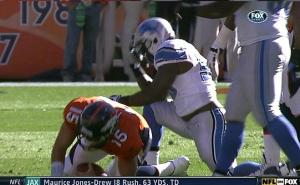
Detroit Lions linebacker Stephen Tulloch strikes a "Tebowing" pose immediately following his sack of the quarterback
Personally, I haven’t quite decided who is right or wrong with respect to the issue. Nonetheless, I can confidently state that if you are a professional athlete, the act of Tebowing opens you up to more negative criticism than praise, even when your intentions are playful and innocent. How does it possibly promote your brand as a professional? It doesn’t. If anything, professional athletes who imitate the kneel risk coming off as absolute jerks who are insensitive towards other individuals’ faith and the ways in which they express it. They further risk alienating themselves from the aforementioned fan base.
Accordingly, I’d like to highlight another figure in professional sports who is worthy of more than mere imitation: Oklahoma City star forward Kevin Durant. This past Monday, October 31st, Durant—one of many NBA players who currently sits on the sidelines while Billy Hunter and the Player’s Association negotiates with the league and its owners regarding a new collective bargaining agreement—decided to engage his twitter followers by expressing his boredom and need to be active. Soon thereafter, the following tweets were exchanged between Durant and Oklahoma State student George Overbey regarding a possible opportunity for Durant to join George’s Fraternity in a flag football game that night:
@KDTrey5: This lockout is really boring..anybody playing flag football in Okc..I need to run around or something!
@groverbey: Got a game tonight in Stillwater!! I need a deep threat!! RT @KDTrey5: This lockout is really boring..anybody playing flag football in Okc..
@KDTrey5: @groverbey can I play
@groverbey: Can you catch?? Weve won the ‘ship for 3 years! Tonight @ 10 RT @KDTrey5: @groverbey can I play
@KDTrey5: @groverbey forreal?
@groverbey: Only if you bring your A game. Yes for real! Come up early and hangout, go over some plays RT @KDTrey5: @groverbey forreal?
Durant and George subsequently exchanged several private twitter messages and text messages, which led to Durant picking up George and several of his friends from their residence in his lavish—but very modest—van and driving them to the flag football game in Stillwater, Oklahoma.
On the football field, Durant further cemented his reputation as being both an elite athlete and a stand up guy. Though the Oklahoma City Thunder could have likely voided his five-year $86 million contract extension due to kick-in this year had Durant sustained a serious injury on the field that night[1], he played the entire flag football game, recorded four touchdown passes on offense and three interceptions on defense. He left the game in the same modest fashion by which he arrived, signing hundreds of autographs and interacting with just about every fan that reached out to him.
Most importantly, Durant left his fans with the sentiment that he doesn’t consider himself special or incapable of interacting with any of them on any given day. Clearly, he’s just another one of the guys. George Overbey summed it up best:
@groverbey: Had one of the best nights of my life tonight.. Game ball goes to @KDTrey5 . 4 tds and 3 picks! Thanks for coming up bro!
As a young professional, often your success directly correlates to the small decisions you make along your career path. Thus far, Durant has figured “it” out, and has made all of the right decisions to propel his professional image off of the charts. To all of you professional athletes who are attempting to brand yourself in a similar fashion, try “Duranting.”
[1] Most NBA Team-Player contracts establish that teams have the discretion to void players’ contracts where they engage in any activity that would subject them to more than a normal risk of injury. For instance, in 2003, the Chicago Bulls waived the contract of second-year player Jay Williams following his involvement in a motorcycle accident that seriously injured him. The team maintained that his contract was no longer legally enforceable and that it did not have to payout his remaining salary because he violated the contract by riding a motorcycle and injuring himself. Williams, nonetheless, received a $3 million buyout from the Bulls as a parting gift.
Friday Morning Workout – August 19, 2011
After a week hiatus, we’re happy to bring back this week’s Friday Morning Workout. Plenty of things to get your sports mind going on one of the last Summer Friday’s.
Former NFL QB Jim McMahon is part of a group of former players suing the NFL over concussion related injuries
Terrelle Pryor will be allowed to participate in next week’s NFL Supplemental Draft, but will be suspended for five games. Sounds like Roger Goodell wants to be commish of the NFL and the NCAA.
Proof that the only way to spur the economy is more sports. Forbes examines how Boston is growing because of sports.
I’m only linking NASCAR here because of the Michigan ties. Apparently Pure Michigan is sponsoring a race, and its paying off for them.
The Wilpons will be in court today, trying to get at least part of the $1 billion lawsuit against them dismissed. After this week’s earlier ruling by the 2nd Circuit, it doesn’t look promising.
The New Meadowlands Stadium, home of the New York Giants and New York Jets, is going to be known as MetLife Stadium. MetLife was already a cornerstone sponsor for the stadium, paying about $7M a year. The naming rights deal will cost them somewhere in the neighborhood of $20M a year.
For the doctors and Padres fans out there, a sad story of a star prospect forced into early retirement.
It’s probably not a good idea to invest in sports in Denver. Apparently they can’t even support the franchises they have.
Fox and the UFC reached a groundbreaking deal to put UFC on network TV. F/X will have the cable rights. Boxing better get its act together, because MMA is clearly in the driver’s seat right now.
NBA players looking to go to Europe may have hit a roadblock. Apparently the insurance is very expensive.
And in case you were under a rock, make sure to read this incredible story about the rampant NCAA rule breaking occuring at the University of Miami since 2002.
